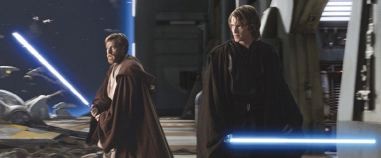Space opera finale

In creating Revenge of the Sith, the third (chronologically) and final (cinematically) installment in the six-film Star Wars saga, George Lucas confronted a writing challenge unprecedented in movie history. Not only was he required to answer the questions and resolve the problems raised in The Phantom Menace (1999) and Attack of the Clones (2002), but he had to conclude the film in such a way that it could lead seamlessly into the first episode of the original trilogy—a film that was released 28 years ago. It’s the movie equivalent of an ancient builder lowering the final massive block into a mammoth pyramid, knowing that unless this stone settles in perfectly against the others, the entire structure will collapse.
If that chore wasn’t daunting enough, consider the huge expectations of the millions of Star Wars fans worldwide as well as the naysayers who are salivating over the opportunity to nail Lucas to the wall.
What’s remarkable, given all this, is how successful Revenge of the Sith is and how closely it adheres to the ideals that accompanied the installments of the 1970s and 1980s, when Lucas declared that the saga is about “a father who is redeemed by his children.”
For those not schooled in all things Star Wars, the latest film concerns the transformation of Anakin Skywalker, dubbed “the chosen one” by the Jedi Council, into Darth Vader, the dark lord of the Sith and one of the key characters in the original trilogy—A New Hope (1977), The Empire Strikes Back (1980) and Return of the Jedi (1983).
We knew from the earlier films that Anakin turns into Vader (there’s that chronology problem again), but why? And why can’t the various Jedi, including his loving teacher, Obi-Wan Kenobi, the steady Mace Windu or the eternally wise Yoda, lead him back into the light of the Force and away from the dark side?
In its art and structure, Revenge of the Sith is the most successful Star Wars film since The Empire Strikes Back. Lucas has stripped away most of the tedious and unnecessary expository scenes (all that stuff about the trade federation’s woes has been deep-sixed), replacing them with a few quick asides to address the problem. (We don’t really care about the inner workings of the Galactic senate.) And he has reinserted much of the comedy and the quasi-slapstick tone (especially in the first half-hour with C-3PO and R2-D2), along with the swashbuckling bravado (Anakin, like Errol Flynn from an earlier generation, is the bravest and most talented warrior of all).
More than ever, Lucas allows visuals to reveal both text and subtext—not just in the numerous fights and battle scenes, but also in quieter moments, where a look or reaction speaks volumes about the way a character is feeling or why he decides to do what he does.
To achieve this visual goal, Lucas borrows freely from classic films and directors, most notably in a dramatic overhead shot of Anakin Skywalker leading his troops, which is a direct lift from Leni Riefenstahl’s Triumph of the Will. Film buffs can also spot two-shots borrowed from Ingmar Bergman, establishing shots from Stanley Kubrick, fight choreography from Akira Kurosawa and art design from Fritz Lang. (And the opening battle scene conjures up images of World War II dogfight movies, since it takes place not in outer space but in the atmosphere, which allows for smoke, fire and sight angles that include the ground below.)
The film’s weakness is the dialogue, which has never been one of Lucas’s strong suits. Word has it that Lucas brought in Steven Spielberg to help choreograph the impressive final battle between Anakin and Obi-Wan, which takes place on a volcanic planet. Too bad he didn’t think of bringing in a writer-for-hire (names like John Sayles and David Mamet come to mind) who could have added oomph to the scenes between Anakin and Padmé, the love of his life; between Anakin and the emperor, where they discuss immortality and the cheating of death; or between the emperor and Yoda, where they battle for a man’s soul. As it is, the lines that stick out in the film are the ones that may be construed as having a veiled political agenda, including Padmé’s “So this is how liberty dies, with thunderous applause,” and Anakin’s warning to Obi-Wan that “if you aren’t with me, then you are my enemy.”
Ultimately it isn’t style or action or dialogue that makes Revenge of the Sith a success. It’s the onion-like layers of this moral tale of dueling father figures, self-fulfilling prophecies, visions and premonitions, and conflicted characters who wrestle with temptations, rationalizations and betrayals.





